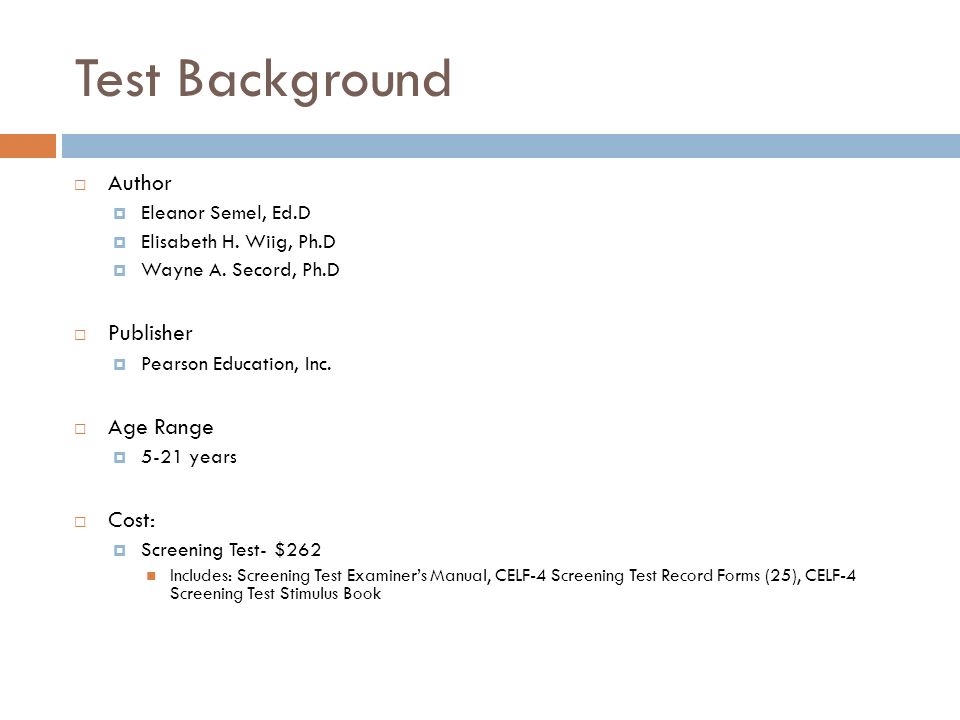CELF 4: Examiner's manual The landmark reference in the field, completely updated: a comprehensive treatment of a disorder that is more prevalent than autism. An English Bride in Scotland In this classic Australian picture book, a dingo catches a wombat and wants to cook him in a stew. But all the other bush animals have a plan to save their. CELF-4 Scoring and Report Assistant Update Version 2.0.1. 15 Oct, 2010 File size: 9.39 mb Downloads: 3044. Celf 4 Manual Celf 4 Scoring Manual. You might want to administer the CELF-4 Rapid of 9-10 and at age 9 the same raw score is a standard score of 4. 6.12 in the Examiner s. Test norms online for the CELF-4, GFTA-2, OWLS, and PLS-4 by Denise Krause on Indulgy.com. Speech Therapy Test Norms - When You Forget the Manual. Celf 4 Scoring Manual PDF - Books Reader - Booksreadr.org Celf 4 Scoring Manual downloads at Booksreadr.org iner s manual, you will be able to obtain accurate test results using the CELF-4. To begin, take a look at page 121 of the Examiner s Manual.
Celf-4 Scoring Manual Pdf

When writing reports for assessments, there are many objective and subjective measures that not even some speech pathologists fully understand. So lets go through some of the terminology.


Scaled scores: For each of the subtests, each student is given a scaled score. In order to allow comparison between students, raw scores (the scores that the student obtains) are generally converted (via math/stats equations) so that the average is 10 (on the CELF-4 and CELF-P2). But some students can get a bit above average, some a bit below average and that’s okay. This range of “a bit below and a bit above average” is the standard deviation which is 3. So if a student is assessed at a score of anywhere between 8-12, this is within average. Once you get to that 1st standard deviation, (ie. a score of 7, or a score 13), this is out of the average. I’ve seen a lot of reports that say that the average is between “7-13”, and I just can’t agree! You want to be within one standard deviation of the mean, not at one standard deviation.
Once the scaled scores of each subtest is added, you get another number. This number on the CELF-4 is also then scaled. This becomes the Language Index. Here, the average is 100, and the standard deviation is 15. So the “normal” range is 86-114. Again, you want to be within the average range.
StandardDeviation: The standard deviations can also refer to other scores and rankings. For example, in one standard deviation (or the “average range”) of the mean include roughly 68% of the sample. When you jump to the next standard deviation (ie. plus or minus 2 standard deviations), roughly 95% of the population is then included.
Celf 4 Scoring Manual
Percentile Rank: Take the percentile rank and put it into this sentence
Celf-4 Manual Del Examinador

“Johnny score’s were equal or above ___% of the aged-matched sample/population”
So if Johnny’s percentile rank was at 1%, then Johnny scored above only 1% of the people tested. This is a very low score and indicates that he is significantly delayed compared to his peers. On the other hand, if he had a score of 90%, then he scored equal or above 90% of people in his age-range. This is a very high score.
Describing severity: The CELF-4/CELF-P2 provides guidelines for the Language Index scores only. For the reports I write, I would use the guidelines (inclusive) as:

- Standard Scores (SS) 115+ as Above Average
- SS 86-114 as Average
- SS 78 to 85 as Mildly Delayed
- SS 71 to 77 as Moderately Delayed
- SS 70 and below as Severely Delayed
I also tend to make up severity levels for the subtests, but these are NOT guidelines put out by the CELF assessments.
Confidence Level: I tend to rarely work out the confidence level, purely because I don’t need to for funding reports (and parents rarely care). But what is it? It describes how confident you are of getting a score if you repeated the same test over and over again. So if you come up with a Confidence Interval of 78 to 90 for a Confidence level of 90%, means that if you repeated the test over and over again, 90% of the scores would be between 78 and 90. Therefore, the higher the Confidence Level, the higher the range of scores.